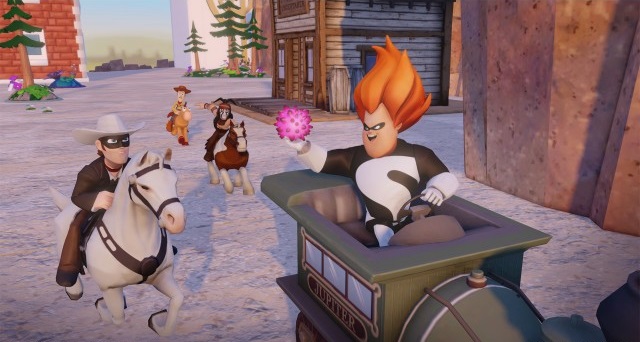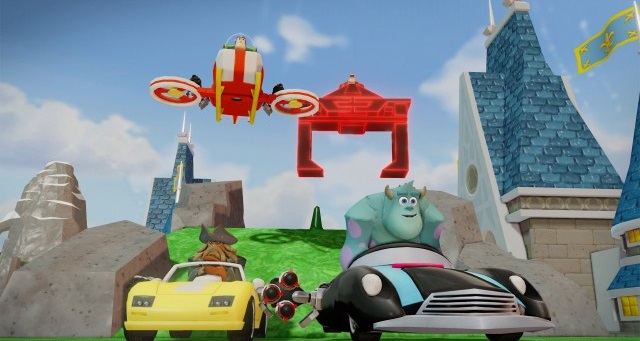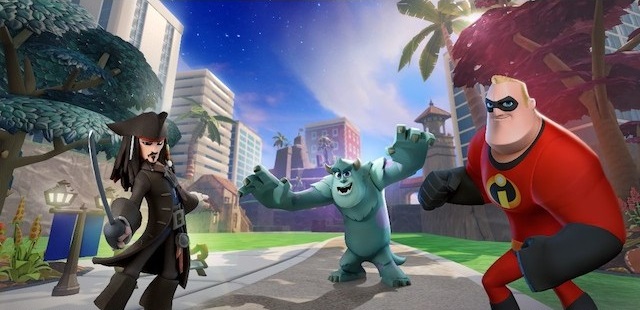What are you going to make in your toybox?
I played Disney Infinity completely wrong when I started: I focused on the playsets. The game is primed to have you jump straight into the create-your-own-games mode of the Toy Box, with its focus being on player creativity to create imaginative games and environments. Luckily, pretty much as soon as you enter the game, it prompts you towards this digital sandbox and the tutorials for building your own environments. This is something that developer Avalanche Software has improved upon from their previous Disney game, Toy Story 3.
Tutorials from the main Toy Box hub, called "Mastery Adventures," explain the basics of gameplay and world creation. This covers everything from basic gameplay, like character combat and driving, to the use of basic physics to create destructible environments, and the use of Creativitoys. These Creativitoys are at the heart of the game mechanics, allowing you to create and link buttons to objects, emitters, and other conditional actions.
To show off the basics of what you can do, the game offers pre-existing toy box worlds that can be downloaded from (as well as uploaded to) Disney's server, and a series of "Adventures" feature pre-made worlds that show off some basic game types—the whole goal being to allow you to explore their creativity. Not every block and toy are freely available at the start, and those that you can get can be unlocked with "spins" (random selection within a set that you can shuffle with other possible sets) that you achieve by leveling up your characters.
The Toy Box is seriously cool and a fantastic introduction to game design in three-dimensional space. It provides you with extensive tilesets for environment creation, character and enemy types, construction materials, and the aforementioned Creativitoys that allow you to create your own conditions for game creation. This includes emitters of different kinds, music players, crowds, and other set dressing. The game sets you up to make your own games, mostly simple ones at first, but with the promise of greater complexity.
Additional themed characters, toys, and blocks are made available by collecting items through the playsets, which are individual environments sold separately depending on which figurines you purchase. For this reason, and to see what they were like, I started with the playsets from the Disney Infinity starter set of Monsters University, Pirates of the Caribbean, and The Incredibles. This was in hindsight a poor choice, because even though these are available immediately from the starting menu, they lack the same kind of player training that you get from playing the "Mastery Adventures" from the Toy Box hub.

Monsters U is unfortunately the weakest of the three. It lacks the brawling element of the other playsets and is more stealth-based (involving a "scare" mechanic after sneaking up on enemies), making failure more punishing. Worst still, I started by playing it in split-screen multiplayer with a friend, where the poor player training was compounded by us confusedly and accidentally skipping the explanatory text, with one person usually finishing it too soon, and getting frustrated with the poor compass directions. This was a bug where you couldn't always select the main mission objectives to be followed by your compass, only the secondary missions, making it hard to find where to go in the main story.
Compass directions and player training were better for Pirates and Incredibles, with Pirates being the most solid. The Incredibles, while fun, ended with missions involving a helicopter with some of the worst flight controls of any game I've played. Car control is also a little difficult, with the cars (or bikes, in the case of Monsters U) sometimes oversteering and having what appears to be one speed: too fast. I smashed into walls and objects with regularity. As I mentioned, the playset for Pirates fared the best, and its ship-to-ship combat was as strong as its platforming sections.
I have not mentioned the physical toys at all, mostly because they're actually the weakest selling point for me in the Infinity bundle. The toys, which sit on the packaged Infinity base, can be leveled up to earn "spins" for more toys in the Toy Box and trophies in the Hall of Heroes, which is essentially Disney Infinity's large trophy cabinet that displays all your toys and power discs. These discs, sold separately, can be placed underneath the toys on the Infinity base to buff your heroes. As you might suspect, the game can't be played without a toy on the base.

The physical toys are obligatory in order to collect everything. Each playset has individual character safes, and a vault that can only be opened by the specific heroes and villains who belong to the set. So there are toys in them you can't get any other way. While some toys come bundled in the playsets, some are also sold separately in packs or individually. Sadly, you cannot play with toys that belong to one playset in another playset (like, say, you can't put a Cars toy in an Incredibles playset). However, you can mix and match the figures in the Toy Box.
In terms of construction, the figurines look like they're made out of flexible vinyl, seated on a plastic base. They're well-made and look identical to the figures in the game; which are meant to resemble toys more than the original film characters. For collectors, they're sure to be a major selling point, and leveling them all up to get better trophies in the Hall of Heroes, while using them to collect all the items in the playset, is a bit of a wet dream for completionists. In a lot of ways, it takes what Activision did with Skylanders and vastly improves on it in almost every way.
Disney Infinity is an amazing game with faults which lie most often in the playsets themselves and some of the poor vehicle controls and inconsistent player training, which feel a bit like the growing pains that we saw in early sandbox games. That said, Avalanche Software has created a game that doesn't just let you play in the Disney sandbox, but gives you the bucket and trowel to build your own castle in it.
-
Toy Box is an amazing, basic game design tool
-
Some playsets are poorly implemented
-
Lots to collect
-
Physical toys are necessary for completion
-
Poor vehicular control
-
Comparable to Skylanders











